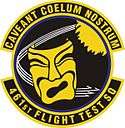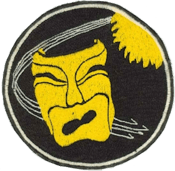461st Flight Test Squadron
| 461st Flight Test Squadron | |
|---|---|
|
An F-35 Lightning II, marked AA-1, lands at Edwards Air Force Base | |
| Active | 12 December 1942 – Present |
| Country |
|
| Branch |
|
| Type | Squadron |
| Role | Flight Testing |
| Part of |
|
| Garrison/HQ | Edwards Air Force Base, California |
| Tail Code | "ED" |
| Engagements | Operation Market Garden |
| Decorations |
|
| Insignia | |
| 461st Flight Test Squadron emblem |
 |
| Aircraft flown | |
| Fighter | F-35 Lightning II |
The 461st Flight Test Squadron (461 FLTS) is a United States Air Force squadron. The squadron is assigned to the 412th Operations Group, Air Force Materiel Command, and stationed at Edwards Air Force Base, California.
Overview
The 461 FLTS squadron performs flight testing on the F-35 Lightning II.[1]
History
World War II
The squadron was organized and trained in the Northeast United States by First Air Force. During training it was a part of the northeaster air defense, linking it to the New York and Boston Fighter Wings.

The 461st Squadron was deployed to England aboard the RMS Queen Elizabeth and served in combat as a part of the VIII Fighter Command from October 1943 to May 1945. The 461st ran operations in preparation for the invasion of the European continent; they supported the landings in Normandy and the Allied drive across France and Germany. The squadron flew P-47 Thunderbolts until they were replaced by P-51 Mustangs in November 1944. Aircraft of the 461st were identified by a magenta/blue diamond pattern around their cowling, carrying fuselage code "QI".
From October 1943 until January 1944, the squadron operated as escort for B-17 Flying Fortress/B-24 Liberator bombers that attacked industrial areas, missile sites, airfields, and communications.
Fighters from the 461st engaged primarily in bombing and strafing missions after 3 January 1944. Its targets included U-boat installations, barges, shipyards, aerodromes, hangars, marshaling yards, locomotives, trucks, oil facilities, flak towers, and radar stations. The 461st bombed and strafed the Arnhem, Netherlands area on the 17, 18, and 23 September 1944 in order to neutralize enemy gun emplacements that were providing support to Allied ground forces during Operation Market-Garden. In early 1945, the squadron's P-51 Mustangs clashed with German Me 262 jet aircraft. The squadron flew its last combat mission, escorting B-17's dropping propaganda leaflets, on 7 May 1945.
The squadron remained in the United Kingdom during the balance of 1945, most personnel were demobilized and returned to the United States, with aircraft being sent to storage facilities in the UK. The squadron was administratively inactivated at Camp Kilmer New Jersey on 10 November 1945 without personnel or equipment.
Cold War

The 461st Fighter-Day Squadron was re-activated at Landstuhl Air Base, West Germany during February 1956, equipped with North American F-100 Super Sabres, being one of the first USAFE squadrons equipped with supersonic jet aircrafts. The aircraft carried three black diagonal stripes on the tail. Between 1956-1959, it conducted air superiority and general support missions as directed by Twelfth Air Force and, later by United States Air Forces in Europe. It also maintained and trained forces for a limited fighter-bomber capability with basic air-to-air weapons. The squadron was inactivated in August, 1959 due to budget restraints.
The 461st was reactivated on 1 July 1977 at Luke AFB, Arizona as a Replacement Training Unit (RTU) for the F-15A Eagle, conducting fighter aircraft aircrew training for pilots. The improved F-15C/D model arrived in 1982 for pilot training. There was no 461st Fighter Squadron during World War II. The Air Force Historical Research Agency consolidated the 461st Tactical Fighter Training Squadron with the World War II 361st Fighter Squadron, giving the squadron a combat heritage and lineage.
In the late 1980s, the F-15E Strike Eagle dual-role version of the F-15C arrived at Luke. The 461 TFTS received the first new F‑15E on 12 April 1988. The 461 TFTS continued to gain aircraft and the first F‑15E transition class (TX) graduated on 24 February 1989. Once qualified, the crews were reassigned to an operational squadron at the 4th Tactical Fighter Wing located at Seymour-Johnson AFB, North Carolina. It was inactivated on 5 August 1994 as part of the phase-down of F-15 training at Luke.
Modern era
The squadron was reactivated at Edwards Air Force Base, California, in 2006. Its mission is flight testing aircrafts, primarily the F-35 Lightning II.[1]
Lineage


- Constituted as 361st Fighter Squadron on 8 Dec 1942
- Activated on 12 Dec 1942
- Re-designated 361st Fighter Squadron, Single Engine, on 20 Sep 1944
- Inactivated on 11 Nov 1945
- Consolidated (19 Sep 1985) with 461st Tactical Fighter Training Squadron, which was constituted as 461st Fighter-Day Squadron on 30 Dec 1955
- Activated on 8 Feb 1956
- Re-designated 461st Tactical Fighter Squadron on 8 Jul 1958
- Inactivated on 1 Aug 1959
- Re-designated 461st Tactical Fighter Training Squadron on 15 Jul 1976
- Activated on 1 Jul 1977
- Re-designated 461st Fighter Squadron on 1 Nov 1991
- Inactivated on 5 Aug 1994
- Re-designated 461st Flight Test Squadron on 23 Oct 2006
- Activated on 27 Oct 2006.
Assignments
- 356th Fighter Group, 12 Dec 1942-10 Nov 1945
- Army Service Forces, 10-11 Nov 1945
- 36th Fighter-Day Group, 8 Feb 1956
- Attached to: 86th Fighter-Interceptor Group, 8 Feb-2 May 1956
- Attached to: 36th Fighter-Day Wing, 1 Oct 1956-7 Dec 1957
- 36th Fighter-Day (later, 36th Tactical Fighter) Wing, 8 Dec 1957-1 Aug 1959
- 58th Tactical Training Wing, 1 Jul 1977
- 405th Tactical Training Wing, 29 Aug 1979
- 58th Operations Group, 1 Oct 1991
- 56th Operations Group, 1 Apr-5 Aug 1994
- 412th Operations Group, 27 Oct 2006–Present
Stations
- Westover Field, Massachusetts (1942–1943)
- New Haven Airport, Connecticut (1943)
- Bradley Field, Connecticut (1943)
- Westhampton, New York (1943)
- Grenier Field, New Hampshire (1943)
- Camp Myles Standish, Massachusetts (1943)
- RAF Goxhill (AAF-345), England (1943)
- RAF Martlesham Heath (AAF-369), England (1943–1945)
- Camp Myles Standish, Massachusetts (1945)
- Landstuhl Air Base, West Germany (1956)
- Hahn Air Base, West Germany (1956–1959)
- Luke Air Force Base, Arizona (1977–1994)
- Edwards Air Force Base, California (2006–Present)
Aircraft
|
|
Operations
See also
References
![]() This article incorporates public domain material from websites or documents of the Air Force Historical Research Agency.
This article incorporates public domain material from websites or documents of the Air Force Historical Research Agency.
- Martin, Patrick. Tail Code: The Complete History of USAF Tactical Aircraft Tail Code Markings. Schiffer Publishing, 1994. ISBN 0-88740-513-4.
- Maurer, Maurer, ed. (1983) [1961]. Air Force Combat Units of World War II (PDF) (reprint ed.). Washington, DC: Office of Air Force History. ISBN 0-912799-02-1. LCCN 61060979.
- Maurer, Maurer, ed. (1982) [1969]. Combat Squadrons of the Air Force, World War II (PDF) (reprint ed.). Washington, DC: Office of Air Force History. ISBN 0-405-12194-6. LCCN 70605402. OCLC 72556.
- USAF 461st Flight Test Squadron History
External links
- Captain John Pershing Perrin DFC, 1943/44 361st Fighter Squadron Ace - who died so others might live
- Wartime air crash. Perrin Memorial
- John Perrin, Class of '40 The Rutgers Oral History Archives
| ||||||||||||||||||||||||||||||||||||||||||||||
| |||||||||||||||||||||||||||||||||||||||||||||||


